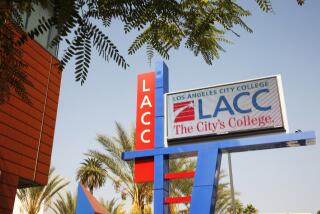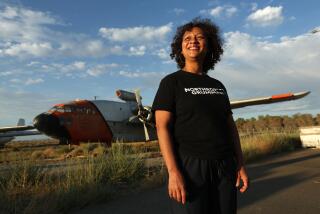Gaining Ground So That a Growing College Can Fulfill Its Mission
- Share via
Mission College in Sylmar, like most community colleges, is one of the workhorses in our higher education system. The college provides a great opportunity for recent high school graduates to pursue higher education in a convenient, local setting. An associate of arts degree enables many students to transfer to the Cal State or University of California systems. And returning students who enroll at community colleges can learn new skills to be more competitive in our ever-changing economy.
Since moving to its permanent location on a 22-acre site in 1991, Mission has consistently had the most rapidly growing enrollment in the entire Los Angeles Community College District while retaining the smallest campus. Built for a student body of 5,000, the campus now houses 7,000 students. Enrollment will continue to skyrocket, with 3,000 additional students expected over the next five years. Demand for affordable higher education has never been greater, and the popularity of Mission has begged the question: Where will the students go when there’s no more room?
All of these students and 58 full-time faculty are crammed into 24 classrooms and 16 laboratories. Although the college is building a 20,000 square-foot collaborative studies building with 12 more classrooms and additional office space, it’s not enough to accommodate the tremendous growth. As one student recently told me: “My high school was severely overcrowded. Mission has 2,000 more students and only half the number of classrooms. When the parking lot fills up, I have to park in the surrounding neighborhood. I know the neighbors aren’t too happy about that.”
Mission needs room to grow. But because of land constraints, there’s no clear direction in which to expand. The campus is landlocked by Hubbard Street on the northwest and Eldridge Avenue on the southwest. On the northeast, there’s El Cariso Regional Park, home to equestrian trails and a hang-gliding facility. And on the southeast, the college is bordered by El Cariso Golf Course and baseball diamonds. What’s a growing college to do?
One idea is to build up instead of out by building high-rise complexes on the current site. However, this option would most likely meet opposition from local residents--not to mention that the buildings would obscure the view of the surrounding mountains. Moreover, it would add capacity without adding parking, already in short supply. The only truly viable solution is to reconfigure land use, consolidating unused and vacant spaces to meet the needs of a growing student population.
But we can’t pursue Mission’s expansion willy-nilly. It’s essential that it be done in a way that balances the needs of the college, the neighborhood and the groups that use adjacent recreational areas. Neither should the college’s expansion be held up by jurisdictional disputes among various entities overseeing infrastructure, transportation, zoning and, most important, funding.
That’s why I’m asking the three major parties involved--the city of Los Angeles, Los Angeles County and the college district--to put their heads and resources together and develop a sound proposal for how best to expand Mission. Each entity--including the local community--must participate in the planning process from top to bottom, having as a goal a specific expansion plan we can all support.
It’s no secret that expansion studies and implementation will cost money. Already, $4.7 million in state funds are being used to construct the collaborative studies building. But students, faculty and staff at Mission can’t afford to wait any longer. We must start the process now by funding the study. Once we have a blueprint and a plan in place, the students and community, along with city, county and community college district, will be able to effectively lobby for land acquisition funds.
Mission is a gem of the northeast San Fernando Valley, providing a wonderful setting for the pursuit of higher education. We must allow it to continue to shine so that future generations of students can be given the tools they need to succeed in the workplace of tomorrow. Mission College has grown up right before our eyes. And now, we as a community must grow along with it.
More to Read
Sign up for Essential California
The most important California stories and recommendations in your inbox every morning.
You may occasionally receive promotional content from the Los Angeles Times.













